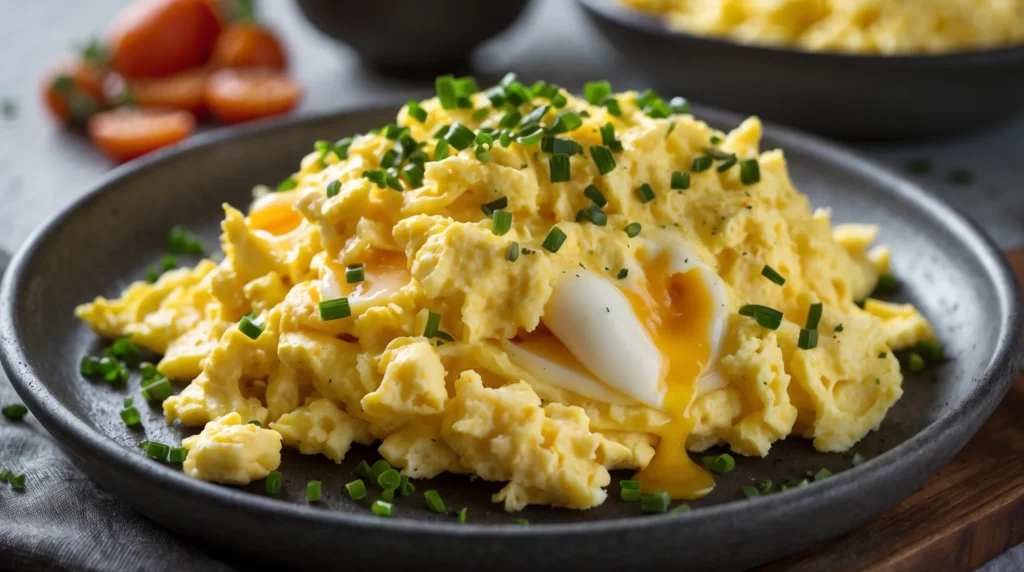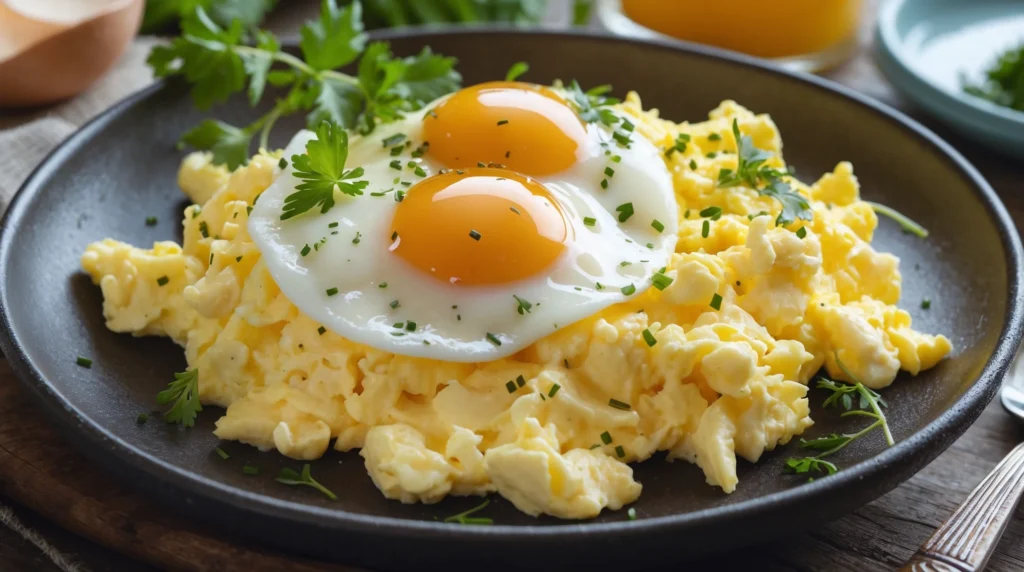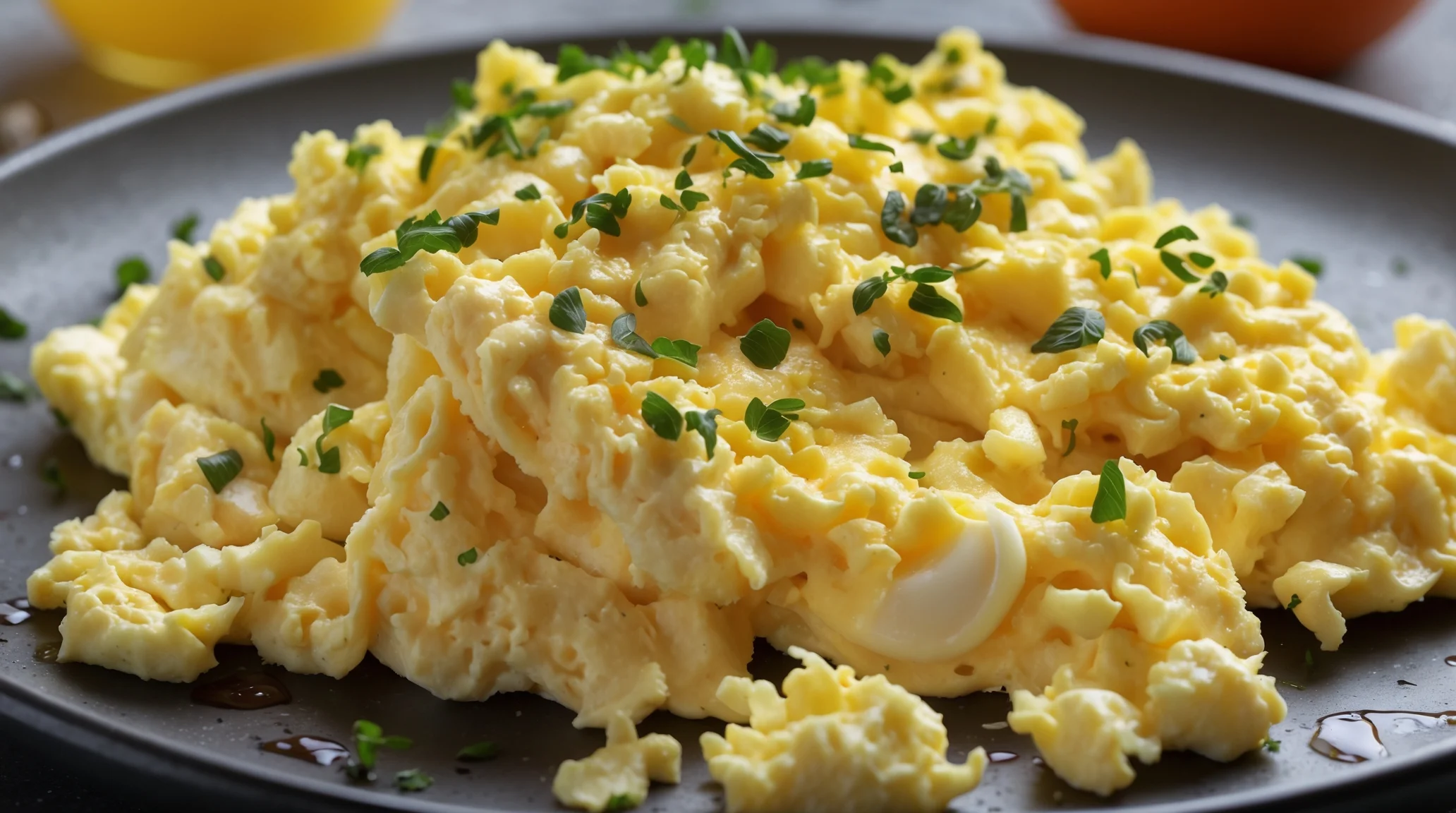Scrambled eggs are one of the most beloved dishes worldwide, celebrated for their simplicity, versatility, and universal appeal. Found in nearly every cuisine, from the American diner breakfast to European café offerings and Asian-inspired dishes, scrambled eggs showcase their adaptability and timeless appeal. Whether served alongside toast in a traditional English breakfast, as part of a Mexican breakfast burrito, or with herbs and spices in Middle Eastern shakshuka, scrambled eggs have a way of bringing comfort and nourishment to any meal.
Their versatility makes them ideal for any time of day. As a quick and satisfying breakfast option, a hearty brunch centerpiece, or a light dinner paired with salad or roasted vegetables, scrambled eggs fit seamlessly into countless meal plans. They’re quick to prepare, easily customizable, and endlessly creative, making them a staple for home cooks and professional chefs alike.
When it comes to texture, scrambled eggs cater to every preference. Soft scrambled eggs are cooked gently, resulting in a rich, creamy texture with delicate curds, while hard scrambled eggs are cooked thoroughly for a firmer, dryer consistency. This versatility in preparation allows scrambled eggs to suit diverse tastes and occasions, solidifying their place as a global culinary favorite.

What Are Scrambled Eggs?
Scrambled eggs are a simple yet sophisticated dish made by whisking eggs and cooking them gently. Their delicate texture and ability to adapt to countless variations make them one of the most popular breakfast choices.
The key to great scrambled eggs lies in fresh ingredients. Using fresh eggs ensures better texture, flavor, and nutritional value. Not sure if your eggs are fresh? Perform a quick egg freshness test by placing an egg in a glass of water. If it sinks, it’s good to go!
Why Are Scrambled Eggs a Popular Choice?
Scrambled eggs are more than just a breakfast staple. They’re:
- Quick to prepare: Ready in under 10 minutes.
- Nutrient-rich: A fantastic source of protein, essential vitamins, and minerals.
- Incredibly versatile: Can be paired with toast, veggies, or meats to create a full meal.
For those looking to minimize their environmental impact, using pasture-raised eggs is a sustainable option that delivers exceptional taste and supports eco-friendly farming practices.
The Nutritional Value of Scrambled Eggs
Eggs are a nutritional powerhouse, making them an excellent choice for any meal. Here’s what makes them stand out:
- High-quality protein: Eggs contain all nine essential amino acids.
- Rich in vitamins: Including B12 (for energy), D (for bone health), and A (for vision).
- Packed with minerals: Selenium, phosphorus, and iron.
- Low-calorie option: When prepared with minimal fat, scrambled eggs are both filling and low in calories.
This balance of nutrients makes scrambled eggs a perfect choice for a healthy lifestyle.

How to Make Perfect Scrambled Eggs: A Step-by-Step Guide
Essential Ingredients
Before you start, gather these basic ingredients:
- Eggs: Use fresh, large eggs for the best results.
- Butter: Unsalted butter adds richness to the flavor.
- Salt: Sea salt or kosher salt is ideal for enhancing the eggs’ natural taste.
- Optional: Cornstarch slurry, milk, or cream for texture variation.
Tools You’ll Need
- A nonstick pan for even cooking.
- A rubber spatula to gently fold the eggs.
- A whisk or fork for beating the eggs.
Cooking Techniques to Master
- The Circling Method
- Heat butter in a nonstick pan over medium heat until melted.
- Pour whisked eggs into the center of the pan.
- Let the edges begin to set, then gently push the eggs inward in a circular motion with a spatula.
- Repeat until the eggs are creamy and slightly undercooked.
- The Low and Slow Method
- Cook eggs on low heat, stirring slowly.
- This method takes longer but yields ultra-creamy scrambled eggs.
- The Chopsticks Method
- Continuously stir eggs with chopsticks while cooking over medium heat.
- This creates smaller curds and a fluffy texture.
Hacks for Fluffier and Creamier Eggs
Take your scrambled eggs to the next level with these simple hacks:
- Cornstarch Slurry: Whisk a teaspoon of cornstarch with water and add it to beaten eggs for a light, airy texture.
- Dairy Additions: Sour cream, Greek yogurt, or heavy cream create richer, creamier eggs.
- Pre-Salting: Add salt to the eggs before cooking to prevent the proteins from binding too tightly.
Creative Variations to Enhance Flavor
Scrambled eggs are a blank canvas for culinary creativity. Here are some ideas to add flavor and variety to your eggs:
Cheese Additions
- Shredded cheddar for a classic touch.
- Gruyère or Parmesan for a gourmet twist.
- Goat cheese for a tangy, creamy texture.
Vegetable Add-Ins
- Sautéed bell peppers or spinach.
- Caramelized onions or mushrooms.
- Fresh tomatoes or avocado slices.
Herbs and Spices
- Fresh basil, chives, or dill for a burst of freshness.
- Smoked paprika or turmeric for depth of flavor.
- Everything bagel seasoning for a savory kick.
Serving Suggestions
Scrambled eggs can be served in endless ways. Pair them with:
- Avocado toast: A healthy and trendy choice.
- Biscuits and gravy: For a hearty, Southern-inspired meal.
- Breakfast wraps or sandwiches: Perfect for busy mornings.
- Pancakes or waffles: To balance sweet and savory flavors.
Consider garnishing with fresh herbs or a sprinkle of cheese to add a finishing touch.
Storing and Reheating Scrambled Eggs
How to Store Leftovers
- Place scrambled eggs in an airtight container and refrigerate for up to 4 days.
- For longer storage, freeze them in a freezer-safe bag for up to 6 months.
How to Reheat
- Warm eggs in a nonstick pan over low heat, adding a small amount of butter or oil.
- Stir occasionally to maintain a soft, creamy texture.
Proper storage and reheating ensure you enjoy scrambled eggs with their original flavor and texture.
Frequently Asked Questions About Scrambled Eggs
1. How are scrambled eggs made?
Scrambled eggs are made by whisking eggs until the yolks and whites are fully combined, then cooking them gently in a pan with butter or oil. The key is to stir the eggs consistently as they cook to form soft curds. The cooking technique can vary depending on whether you prefer soft or hard scrambled eggs, but the process always emphasizes even cooking and attention to texture.
2. Do you add milk into scrambled eggs?
Adding milk to scrambled eggs is optional and often debated. Milk can create a creamier texture, but too much can dilute the flavor and make the eggs watery. Many chefs prefer using butter for richness or sour cream for creaminess instead of milk. If you choose to add milk, use just a splash for the best results.
3. What is the trick to scrambled eggs?
The secret to perfect scrambled eggs lies in a combination of technique and preparation:
- Use fresh eggs for the best taste and texture.
- Salt the eggs before cooking to enhance flavor and prevent over-binding of proteins.
- Cook them on low to medium heat and stir gently to create soft, fluffy curds.
- Remove the eggs from heat just before they’re fully cooked, as they continue to cook off the heat.
4. What is the difference between scrambled eggs and an omelette?
Scrambled eggs and omelettes are both made from whisked eggs but differ in preparation and texture. Scrambled eggs are stirred continuously during cooking to create soft, fluffy curds, while an omelette is cooked without stirring, resulting in a flat, firm texture that can be folded around fillings like cheese, vegetables, or meats.
5. Are scrambled eggs fully cooked?
Scrambled eggs should ideally be cooked until they are just set but still moist. Soft scrambled eggs are slightly undercooked, giving them a creamy texture, while hard scrambled eggs are cooked thoroughly for a firmer consistency. Both are safe to eat as long as they reach a minimum internal temperature of 160°F (71°C).
6. How do you make fluffy egg whites?
To make fluffy egg whites, separate the yolks from the whites and whisk the whites vigorously until they form soft peaks. You can use a whisk, hand mixer, or stand mixer for this step. Fold the fluffy whites gently into beaten yolks or other mixtures to create airy dishes like soufflés or lighter scrambled eggs. A pinch of cream of tartar can help stabilize the egg whites during whisking.
Conclusion
Scrambled eggs are a simple yet endlessly adaptable dish that has earned its place as a global favorite. By mastering essential techniques like whisking, salting before cooking, and using methods such as the circling or low-and-slow approach, you can achieve the perfect texture—whether you prefer soft, creamy curds or firm, fluffy eggs. Adding creative flavor enhancers like cheese, herbs, or vegetables allows you to customize your scrambled eggs to suit any palate or occasion.
To make the most of your breakfast, pair your scrambled eggs with other classics like these Classic Fluffy Pancakes for a balanced and satisfying meal. Don’t be afraid to experiment with new ingredients and methods to elevate this timeless dish. From pairing eggs with hearty sides like Chicken Noodle Soup to exploring new preparation styles, the possibilities are endless.
In the end, scrambled eggs remain a comforting and versatile option, offering nourishment and room for creativity. With a few simple techniques and a touch of imagination, you can transform them into a meal that is always satisfying and delicious.

